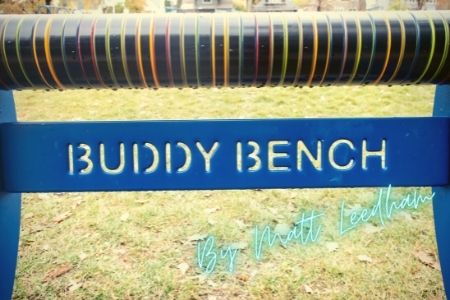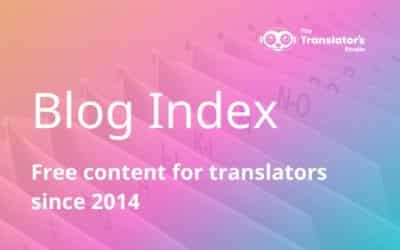Translation students who join our translation courses have the option to ask for a study buddy. By working with other translation students, you get extra translation practice and accountability, all while making new friends. This review of our study buddy scheme was written by our former student Matt Leedham.

What is The Translator’s Studio study buddy scheme?
The study buddy scheme started out of the need for course tutees and DipTrans exam candidates to have regular, accountable translation practice. This enables them to supplement individual study on the courses offered by The Translator’s Studio and translate more texts.
Very simply, it involves two or more course tutees with similar text genre preferences being paired up. They then contact one another and schedule regular video conference calls to discuss translation exercises that they have both worked on independently.
The Translator’s Studio organises this as one of their free products and services for students on their Conversion and Advanced translation courses.
Translation Exercises
The translation exercises might involve DipTrans past papers, texts that other course members have previously created (adapted from newspapers and other sources relevant to the text genres), or papers that the study buddies create themselves from online resources.
For example, the DipTrans general paper is often taken from quality newspapers and relates to current affairs. So, translation study buddies can create a general paper to translate by adapting an article from online daily newspapers written in their source language. It’s a great way to learn Spanish words that you may not otherwise encounter.
Timing
The idea is for buddies to complete their translations in timed conditions to provide a clear indication of level and preparedness for the exam setting. But with a very tricky text, that isn’t always possible. Sometimes it’s more effective to research while doing the translation.
The frequency of meetings varies depending on the buddies’ availability for translating (more on that later).
Why it’s a good scheme
When two buddies with the same languages are planning to sit the same text genres in the DipTrans exam, the buddy scheme provides enormous benefit. This is because both bring their own background and experience, which enables them to learn from each other.
It’s an opportunity to exchange ideas, learn from the other translator’s life experiences and perhaps challenge certain cultural preconceptions that influence their understanding of languages.
Of course, with each practice translation, you also build your vocabulary while learning Spanish (or learning French) through the original text. This is while improving your professional writing skills through the English version.
My experience with the translation study buddy scheme
I was paired with Gordon in April 2021. Both of us were looking to increase our volume of words translated ahead of the DipTrans exam. We arranged to produce our own work based on a Spanish text and then meet once a week to discuss the translation in detail. As both of us are regular readers of the Spanish daily El Mundo, we often adapted texts from their business and science sections to create our texts to translate.
We kept as close as possible to the word count of the DipTrans exam papers (400–450 for the semi-specialist options and 600 for the general paper). As we noticed a growing trend in the DipTrans papers to focus on Latin America, we also used newspapers from there such as Clarín and La Nación.
For more technical or specialist translation practice, we found open-source academic journals.
Benefits of taking part in the scheme
Below are a few of the main advantages of the study buddy system. For any current tutees on The Translator’s Studio courses, there are ample reasons for pairing up with a course mate who works in your languages.
Flexibility
Gordon and I translated one text per week and alternated who selected the text. One of the great advantages of the study buddy system is the flexibility. In busy weeks, we could reschedule or postpone the session if other commitments made it impossible.
Accountability
The second important benefit to being a study buddy is accountability. Having a regular appointment enabled us both to amass a large body of work. It meant that, in addition to the course translations, we were producing a further translation per week. That’s four per month, which, when added up over a longer period, becomes a significant bank of parallel texts.
It forced me to be disciplined and meant I got more translation practice than I otherwise would have. Working with Gordon kept me on my toes particularly in relation to style guides. When faced with a doubt about capitalisation, punctuation or usage, for instance, my natural temptation is to make a decision based on feel. But Gordon was quick to challenge me. He became very familiar with The Economist Style Guide and would often point me in the direction of ‘page x’ to highlight where I was going wrong.
Improved ability to self-assess
Working with someone else also makes it easier to receive criticism. When judging someone else’s work, you don’t have the same level of attachment as you have to your own. That means you view it more objectively. So, it’s easier to notice mistakes or challenge things that seem jarring. When self-assessing, there’s a temptation to be lazy or unwilling to see or change mistakes.
Terminology
The benefit from working on current topics was significant. It meant we were discovering newly emerging concepts and keeping abreast of current affairs in parallel texts to the type you find in the DipTrans exam. Over time, the steady, regular stream of translations enabled us to expand and update our personal glossaries. By discussing the texts, we got better at understanding and remembering complex terminology. We also established how we’d translate the vocabulary in an exam setting.
A recent example from Autumn 2021 would be NFTs, which kept coming up in the news. Also, as would be expected, we covered a lot of pandemic-related texts, usually with a business angle. Needless to say we became familiar with the term ERTE, Spain’s furlough scheme. This kind of focus on relevant terminology enables you to become a more effective translator.
Translating Skills
The continual practice of drafting, checking, editing and proofreading enables you to hone key translation skills. You get significantly faster and more accurate at the different stages of translating. It becomes clear over time that the hours invested in the translation practice is time well spent as your work improves.
For example, I’ve noticed my writing get better as a result of the study buddy sessions. The more you come across certain expressions or complex grammar, the more your language skills improve and the quicker and easier it becomes to translate challenging vocabulary.
Cultural Learning
A word of warning to potential buddies: the calls can go on for quite a while! For Gordon and I, our discussions typically lasted between 90 minutes and two hours. That said, at the end of each session, we always agreed it was worth the time.
In terms of cultural learning, working with Gordon also meant gaining an insight from someone who has lived in Spain for a number of years. Hearing stories of rural Malaga province, I inevitably find myself comparing it with the buzz of Barcelona, where I spent half of my year abroad during my language degree.
Gordon’s knowledge of accountancy means he brings expertise to the business texts that I often lack. It was also fascinating to observe how varied life experiences, in different countries and work contexts, can shape someone’s language and editing style.
Give it a go!
To sum up, when you join the Translation Conversion Course or the Advanced Translation Course, you’ll be offered the opportunity to get one or more translation study buddies. The Translator’s Studio doesn’t charge for this service and I highly recommend you consider giving it a go.
Read more about our translation courses for Spanish- and French-to-English translators. Get your free level test here.





0 Comments